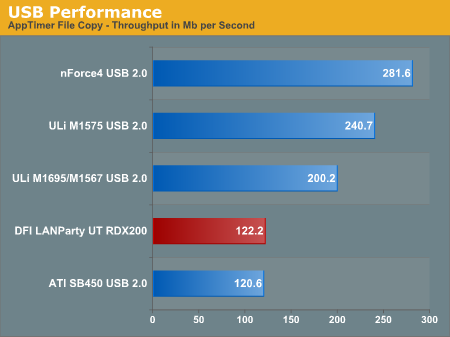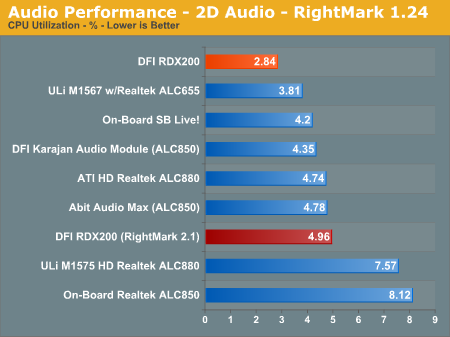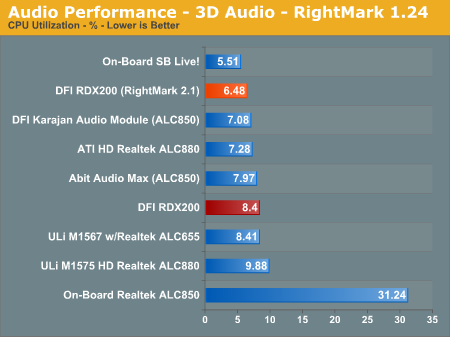DFI LANParty UT RDX200: ATI’s Crossfire AMD for the Bleeding Edge
by Wesley Fink on October 18, 2005 11:03 AM EST- Posted in
- Motherboards
Performance of Features
When you receive a board Friday afternoon that will go on sale Tuesday morning, there is sometimes just not enough time to complete all the tests that you initially planned. In the interest of bringing you the most significant test results on the DFI RDX200, we concentrated on two areas of interest, specifically USB Performance and CPU utilization of the Karajan audio module.
For additional information on the performance of other Storage, Ethernet, and Firewire, please go to other recent ATI Rx480/482 reviews at "ATI's Crossfire: Best Overclocker on the Market?" and "Sapphire PURE Innovation - ATI's Chipset for the AMD Enthusiast". The performance of the feature accessory chips present on the DFI RDX200 are tested in those reviews.
USB Performance
USB has been a problem area for the ATI SB450 chipset, so we decided to see if anything had changed. We ran our standard USB throughput test on the DFI using an external USB hard drive.
Our test method uses a RAM disk as our "server", since memory removed almost all overhead from the serving end. We also managed to turn off disk caching on the USB and Firewire side by setting up the drives for "quick disconnect" and our results were then consistent over many test runs.
We use just 1GB of fast 2-2-2 system memory set up as a 450MB RAM disk and 550MB of system memory. Our stock file is the SPECviewPerf install file, which is 432,533,504 bytes (412.4961MB). After copying this file to our RAM disk, we measured the time for writing from the RAM disk to our external USB 2.0 or Firewire 400 or Firewire 800 drive using a Windows timing program written for AnandTech by our own Jason Clark. The copy times in seconds were then converted into Megabits per second (Mb) to provide a convenient means of comparing throughput. Higher Rates, therefore, mean better performance.
There is an alternative in the ULi M1575 southbridge, which we recently tested. The ULi SB provides competitive USB performance and the SATA2 ports, which are missing from the ATI SB450 - and it is available today. We asked DFI why they chose the SB450 instead and they responded that the design work for the RDX200 was far along when the M1575 became an alternative. DFI also pointed out that M1575 and SB450 are not pin-compatible, thus making a last minute change in southbridge to be a very costly option. The SB600 should be pin-compatible with SB450, as M1575 is pin-compatible with M1573. When the SB600 is available, DFI will use the SB600 instead. They may also consider an SB change in their upcoming ATI dual x16 motherboard.
Audio Performance
For audio testing, we used Rightmark 3D Sound CPU utilization test, which is the same benchmark run in our earlier nForce4 SLI and Ultra roundups. This benchmark measures the overhead or CPU utilization required by a codec or hardware audio chip. We tested performance both with the earlier version 1.24 that we had used for past testing and the latest version 2.1. As you will see, 2.1 does yield different performance numbers.
It is very important to point out that the DFI LANParty UT RDX200 is the first Athlon 64 retail motherboard to deliver Azalia High Definition audio. Those who have been complaining about the poor AC'97 audio present on most AMD boards should be very pleased to find Azalia HD on the ATI chipset boards.
DFI claims that the Karajan module lowers noise using an on-board audio solution. We did some subjective listening tests with the DFI's version of Azalia HD through a Dolby amplifier and a 5.1 speaker setup. We really couldn't hear a huge improvement over our last listening tests of ATI Azalia HD. Perhaps that was because our last experience with Azalia HD on AMD was so good. HD really is in a completely different league from the other audio solutions that we have tested on Athlon 64. Noise was virtually non-existent, and imaging and depth were superb when listening to demanding CDs. The same CD sounded thin, noisy, and artificial through a more common ALC850 fed to the same Dolby amp and 5.1 speakers. This is not to say that the Azalia HD is at the same level as the very best audio cards, but it is a lot closer than you might think.
When you receive a board Friday afternoon that will go on sale Tuesday morning, there is sometimes just not enough time to complete all the tests that you initially planned. In the interest of bringing you the most significant test results on the DFI RDX200, we concentrated on two areas of interest, specifically USB Performance and CPU utilization of the Karajan audio module.
For additional information on the performance of other Storage, Ethernet, and Firewire, please go to other recent ATI Rx480/482 reviews at "ATI's Crossfire: Best Overclocker on the Market?" and "Sapphire PURE Innovation - ATI's Chipset for the AMD Enthusiast". The performance of the feature accessory chips present on the DFI RDX200 are tested in those reviews.
USB Performance
USB has been a problem area for the ATI SB450 chipset, so we decided to see if anything had changed. We ran our standard USB throughput test on the DFI using an external USB hard drive.
Our test method uses a RAM disk as our "server", since memory removed almost all overhead from the serving end. We also managed to turn off disk caching on the USB and Firewire side by setting up the drives for "quick disconnect" and our results were then consistent over many test runs.
We use just 1GB of fast 2-2-2 system memory set up as a 450MB RAM disk and 550MB of system memory. Our stock file is the SPECviewPerf install file, which is 432,533,504 bytes (412.4961MB). After copying this file to our RAM disk, we measured the time for writing from the RAM disk to our external USB 2.0 or Firewire 400 or Firewire 800 drive using a Windows timing program written for AnandTech by our own Jason Clark. The copy times in seconds were then converted into Megabits per second (Mb) to provide a convenient means of comparing throughput. Higher Rates, therefore, mean better performance.

There is an alternative in the ULi M1575 southbridge, which we recently tested. The ULi SB provides competitive USB performance and the SATA2 ports, which are missing from the ATI SB450 - and it is available today. We asked DFI why they chose the SB450 instead and they responded that the design work for the RDX200 was far along when the M1575 became an alternative. DFI also pointed out that M1575 and SB450 are not pin-compatible, thus making a last minute change in southbridge to be a very costly option. The SB600 should be pin-compatible with SB450, as M1575 is pin-compatible with M1573. When the SB600 is available, DFI will use the SB600 instead. They may also consider an SB change in their upcoming ATI dual x16 motherboard.
Audio Performance
For audio testing, we used Rightmark 3D Sound CPU utilization test, which is the same benchmark run in our earlier nForce4 SLI and Ultra roundups. This benchmark measures the overhead or CPU utilization required by a codec or hardware audio chip. We tested performance both with the earlier version 1.24 that we had used for past testing and the latest version 2.1. As you will see, 2.1 does yield different performance numbers.



It is very important to point out that the DFI LANParty UT RDX200 is the first Athlon 64 retail motherboard to deliver Azalia High Definition audio. Those who have been complaining about the poor AC'97 audio present on most AMD boards should be very pleased to find Azalia HD on the ATI chipset boards.
DFI claims that the Karajan module lowers noise using an on-board audio solution. We did some subjective listening tests with the DFI's version of Azalia HD through a Dolby amplifier and a 5.1 speaker setup. We really couldn't hear a huge improvement over our last listening tests of ATI Azalia HD. Perhaps that was because our last experience with Azalia HD on AMD was so good. HD really is in a completely different league from the other audio solutions that we have tested on Athlon 64. Noise was virtually non-existent, and imaging and depth were superb when listening to demanding CDs. The same CD sounded thin, noisy, and artificial through a more common ALC850 fed to the same Dolby amp and 5.1 speakers. This is not to say that the Azalia HD is at the same level as the very best audio cards, but it is a lot closer than you might think.










48 Comments
View All Comments
nsk - Tuesday, October 18, 2005 - link
Having 8 SATA ports is very useful. kudos to DFI for putting that extra SiI chip.Diasper - Tuesday, October 18, 2005 - link
What's good about this board IMO is the Azalia Audio and CPU utilisation - *very* impressive for on-board audio. Performance and options are of course very good as well although nothing worth paying significantly more for.However, just to point out one additional benefit of the board that you guys might not have realised yet is that it could very much make a quiet computer guy very happy as the active chipset cooler can very easily be replaced with a passive heatsink eg Zalman one. Trying that with many NF4 is impossible unless resorting to modding - with some coming up with some quite radical solutions. After all there's no point buying a nice and expensive case like the Antec P180 and then a quiet PSU ontop only to have a screaming NB fan in your NF4 - unless resorting to modding.
However, as others have mentioned deal-breakers include poor USB performance and no SATA 2 and possibly cost althought we'll have to wait on that one.
Azkarr - Tuesday, October 18, 2005 - link
Well, it's on newegg now. $239? I think thats just about $50 too much for not having SATA II. Plus, none of the Crossfire cards except the XL are out, so I don't think there's a point to buying this board.http://www.newegg.com/Product/Product.asp?Item=N82...">Newegg
Slaimus - Tuesday, October 18, 2005 - link
Which sound driver was used to get such a low CPU usage score? Realtek or ATI?Wesley Fink - Tuesday, October 18, 2005 - link
We used the Realtek sound driver on the DFI CD with the board for testing. We did use the current 5.10 Catalyst drivers, however, instead of the Crossfire 5.8 drivers on the CD.nourdmrolNMT1 - Tuesday, October 18, 2005 - link
http://images.anandtech.com/reviews/motherboards/d...">http://images.anandtech.com/reviews/motherboards/d...WTF is up with the one SATA connector? sata7 specifically it looks completely off.
emilyek - Tuesday, October 18, 2005 - link
A clawhammer for overclocking?Also,
A real test of the 1T/2T stuff would be gaming benchmarks for 2 x 1G @ 1T and 4 x 512 @ 2T. That's the test I want to see.
ozzimark - Tuesday, October 18, 2005 - link
this stands out at me.http://images.anandtech.com/graphs/dfi%20rdx200_10...">http://images.anandtech.com/graphs/dfi%20rdx200_10...
that data is... somewhat useless for the top 5-9 boards, as it's obviously a cpu limitation. try oc'ing the htt/fsb with the fx-57 and watch the board break 400mhz
Pete84 - Tuesday, October 18, 2005 - link
Horrible!! The only things going for this board is that I. It has Crossfire and II. It has some nice memory capabilities and III. It has Azaliz.Pathetic USB performance, no SATA II!!! When even budget minded boards have SATA II and this one does not, now that is a serious lapse. Having a seperate raid controller with some SATA II ports would help this, especially so if it was on the PCI-E bus, but wow . . . and price at $230!!!
haelduksf - Tuesday, October 18, 2005 - link
I don't understand why SATA-II is such a big deal to so many people. NCQ has a negligable impact unless you're running a server (on a XFire motherboard...), and the 300MB/s transfer speed has no effect at any time with currently available harddrives.